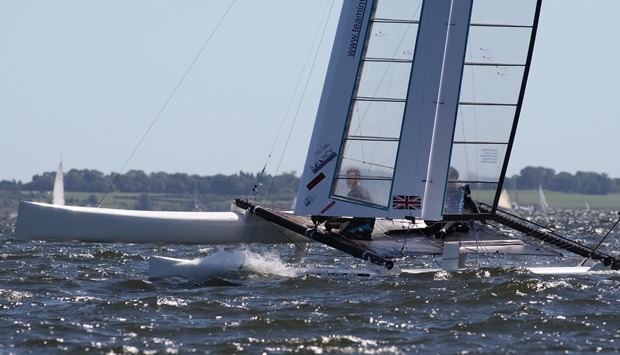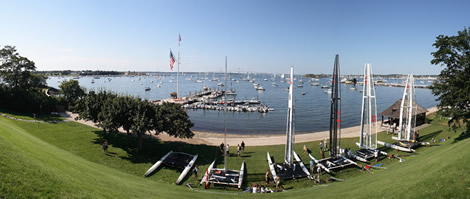One year until C-Class racing returns to the UK
It is now just a year until C-Class catamaran racing returns to British shores for the first time since 1969...
The C-Class came into being in 1956 when the predecessor to ISAF, the International Yacht Racing Union, established four catamaran classes to basic box rules governing length, beam and overall sail area. The C-Class was the second biggest of these (the B Class ending up as the Tornado) defined by LOA 25ft, beam 14ft and sail area of 300sqft.
The International Catamaran Challenge Trophy came into being over a simple dust-up to determine who had the faster boat after the gauntlet was thrown down by the Sea Cliff Yacht Club in Long Island. The challenge was picked up by catamaran designer Rod McAlpine-Downey and John Fisk, Commodore of the Chapman Sands Yacht Club in the UK. The first ICCT was held on Long Island Sound with the British Hellcat II prevailing over the American Wildcat.
From then on the ICCT was held almost every year until the early 1980s. The Brits held on to the ICCT thanks to successful defences skippered by Reg White, subsequently the 1976 Tornado gold medallist, with famous boats including Emma Hamilton and Lady Helmsman. They were beaten by a Danish team in 1969, with successful future challenges coming from Australia and the USA.
Thanks to the maximum sail area limitation, C-Class catamarans evolved to having unarigs, using wingmasts and then to the full wingsail rigs that have become their defining feature ever since.
The ICCT was finally won in 1996 by American Steve Clark's Cogito over the Australian Yellow Pages The Edge III. But after this the event fell into a hiatus and in an attempt to rectify this, the Trustees of the ICCT, the Sea Cliff Yacht Club chose to rewrite their trophy's Deed of Gift deeming that future events would be held in supposedly more popular F18HT catamarans.
The Sea Cliff YC’s move left Steve Clark to continue the C-Class cause, revitalising racing for the exotic catamaran class in 2004 with a new event called the International C-Class Catamaran Championship held in Bristol, RI. This featured Invictus Challenge from the UK, Team Ronstan from Australia, Clark's Cogito and the venerable Patient Lady VI, dating back to 1985.
The next event, held in Toronto in 2007, was convincingly won off Cogito by a new Canadian team led by Fred Eaton sailing Alpha, with two other Canadian teams, one again sailing Patient Lady VI and the other Eaton's B-boat, Off Yer Rocker.
In 2010 the ICCCC returned to Rhode Island held out of the New York Yacht Club in Newport. This featured six teams with Fred Eaton fielding a new boat, Canaan, which in the final ended up taking on and eventually winning against the 33rd America’s Cup winning helmsman Jimmy Spithill sailing with multiple A-Class World Champion, Glenn Ashby aboard the Canadian team's former winner Alpha. Another Canadian team sailed Eaton's latest B-boat Orion; Steve Clark got the opportunity to build a new platform, Aethon, using Cogito's wing; a French team of ORMA 60 skipper Antoine Koch and Jeremie Lagarrigue sailed Patient Lady VI, while the British Invictus Challenge returned with a new wing, their boat sailed by Gordon Kaiser and Vestas SailRocket's Paul Larsen.
There was a lot interest in this event from the America's Cup community at a time when BMW Oracle Racing had won the 33rd America's Cup and was expecting to choose a large wingsail catamaran as the class for the 34th. Since then the AC72 has been unveiled and the first examples launched, the game rising further with the prospect of these boats foiling around San Francisco Bay next summer.
Moves in the America’s Cup has further fuelled interest in the C-Class, although there is a significant difference between the 25ft wingsail cats and the AC45s and 72s in that the latter can use headsails without compromising the size of their wings. As a result C-Class cats are unable to increase their sail area downwind, so their wings have to be substantially more efficient than the AC wings and typically feature multiple elements and twin slots.
Great news for British fans is that the International C-Class Catamaran Championship is return to the UK next summer and even better, the organisers have seen sense and moved on the date so that it no longer clashes with the 34th America’s Cup. Originally scheduled for August 2013, the event will now be held over 23-29 September 2013.
The race area will off Falmouth, with Restronguet Sailing Club (Ben Ainslie’s club during his youth) organising the racing, catamaran expert Brian Phipps at Windsport providing the teams with shore side facilities and Mylor Yacht Club providing access to their splendid new clubhouse.
Canadian Fred Eaton will be returning to defend his title while Steve Clark will be coming with Aethon, sporting a new wing, that wasn’t quite ready for the 2010 event. Fred Eaton’s designer Steve Killing, currently part of Emirates Team New Zealand’s design team, is expected to unveil something new, raising the bar even higher.
Ben Muyl and Jérémie Lagarrigue, who were with the French team in 2010 are now working on separate challenges. Lagarrigue (who we sailed with this summer on L’Hydroptere.ch) is now at the Swiss Team Hydros. Sponsored by Lombard Odier bank, the team will field two boats, their hulls built by Decision SA in Switzerland in North Thin Ply Technology (as used in 3Di sails and the latest Southern Spars masts).
Meanwhile Muyl is helping to build a French challenger – Challenge France, sponsored by ABM Manutention.
In Italy, Challenge Italia project leader Roberto Grippi is also forging ahead and is probably the most advanced in terms of design and crew training. He has gathered some top class names including Francesco Bruni and Pierluigi de Felice, both sailing with Luna Rossa’s challenge for the 34th America’s Cup, their project based in Palermo, Sicily.
In addition to the US team and Canadians, the European challengers look strong and well-funded.
As organisers in the UK, Team Invictus has also had interest from teams in Spain, Australia, and New Zealand and there are even some rumours of another UK team. They are, like Team Invictus, still looking for a sponsor willing to back their project. But it is certainly clear that the class is undergoing a level of interest that hasn’t been seen since the early days of the class in the 1960s.
With one year to go, the game is getting serious now, with many questions and rule clarifications to be sorted out. To this end, the C-Class community is looking to gather in November to discuss all aspects of the event.
Of course Team Invictus intends to compete next year, as well as hosting the event. In parallel with the team’s event organising work, they are working hard to develop a boat which will allow them to improve on their third place in 2010.
The search for major sponsorship continues, for both the event and the development of the new Team Invictus. To date the team has gained in-kind support from Advanced Composites Group in Derbyshire and Oxeon in Sweden, developers of Textreme® and Atlantis Weathergear providing team clothing.
The former two companies will enable the team to develop a new wing concept, designed with the assistance of ANSYS software. According to Invictus’ Norman Wijker the new wing will bring some new development ideas beyond the well-proven benefits of the Cogito wing design. Changes will be both in the concept as well as the design details that allow the wing to work with low drag for upwind and high lift coefficients downwind.
Invictus’ progress has been boosted by a partnership with a new team from Europe which is at present finalising their sponsorship arrangements and will announce very soon. The synergetic partnership will collaborate completely off the water, with the two teams then competing fiercely under their own national flags on the water. This provides both parties with an ability to compete in a world where economic conditions make finding financial support much harder. This partnership is already moving forwards: the first wing will start manufacture in October. Invictus brings to the table wings, fixtures, fittings and controls developed with the help from EADS and Exeter University and their titanium additive layer manufacturing capability.
On the water, Invictus has been without a wingsail since the backstay failure in the Solent in the Weston Cat Open in 2011. In the meantime, helmsman Tom Phipps has kept himself busy, recently becoming Dart 18 National Champion. Invictus is considering its new partner’s offer to sail in Europe over the winter. The 2013 ICCCC is being held in Falmouth where Phipps has cut his teeth as a catamaran sailor.
Phill Brown, Invictus’ composites manufacturing expert, who left the team in 2010, is returning, and they have four new recruits with Huw Traylor and Helen Williams working on sponsorship, Martin Oughton on manufacturing design and George Seyfang their Aerodynamicist.
Progress on Team Invictus can be followed here or on their own website while the 2013 ICCC has a new website here.












Latest Comments
Add a comment - Members log in